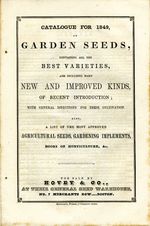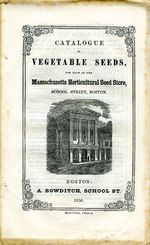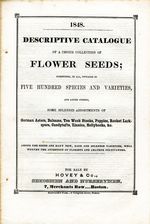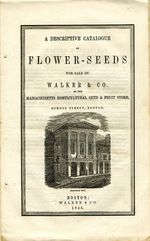The Massachusetts Horticultural Society was established in 1829 in a spirit of cooperation and idealism. The founders intended it as a place where members could share information about new plants and innovations in gardening techniques. In 1845, the Society opened a hall for meetings, exhibitions, a shop, and a library at 21 School Street. Adorned with classical statues, the hall was designed by Richard Bond in the Greek Revival style. It was used until 1864 when the society moved to a building that included a larger exhibition space and a lighter, less damp library.1 The OSU collection contains a selection of catalogues by Samuel Walker and Azell Bowditch who rented the shop, as well as those of other prominent officers and members of the Society: Charles Mason Hovey, John Winship, Parker Barnes, and Joseph Breck. Included in the collection is also a schedule of prizes from the Society’s Exhibition of 1851, which took place at the first Horticultural Hall.
The Massachusetts catalogues in the OSU collection catalogues show the huge range of imported and domestic varieties of seeds, ornamental plants and fruit trees available to Bostonians from some of America’s leading horticulturists before 1851. They also provide evidence that American companies were producing some of their own seeds by the 1840s. In 1849, Hovey’s vegetable seed catalogue states that “European seeds can’t be fully depended on”, and he was undertaking domestic production for seeds except “those which cannot be raised in this country without much difficulty and uncertainty”. Hovey’s Garden Seed catalogue is scanned here. The collection also contains one each of Hovey’s catalogues of ornamental trees and shrubs, and flower seeds and pears.
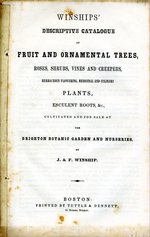
Winships' Descriptive Catalogue of Fruit and Ornamental Trees...etc. Circa 1850s. (Click for more images)
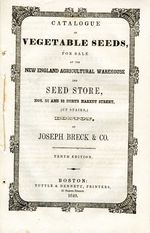
Catalogue of Vegetable Seeds, For Sale at the New England Agricultural Warehouse and Seed Store. 1849. (Click for more images)
While the catalogues are primarily lists, they contain several more modern elements that were becoming more commonplace. For example, some of the catalogues contain item numbers, and flower charts with symbols showing information such as Latin name, common name, hardiness, bloom time, and color. These developments seem to coincide with the gradual emergence of mail order. According to John Harvey, the oldest English surviving example of these innovations is from 1833.2 Some of the catalogues may have been inspired by English models in other ways: the cover of Hovey’s 1848 flower seed catalogue is too similar to those of the London firm of James Carter from the 1840s to be coincidental.
The Massachusetts catalogues in the OSU collection shed light on the early history of mail-order seed and plant shipping. In 1846, Walker and Co. offered seeds to any part of the country, with a note that orders “should be accompanied with a remittance or draft payable in Boston or New York”. In 1849, Breck sent fruit trees and seeds to any part of the country as well as the West Indies and Great Britain. In the same year, Hovey also accepted orders from the south and west and the West Indies and shipped “either direct or by the way of New York, or forwarded by any of the Express Lines or Railroads to any part of the country”. Winship’s catalogue said orders could be received by mail and shipped by rail to the western US and Canada, and Azell Bowditch’s fruit catalogue said, “Orders by mail will be promptly executed”. Despite these offers, getting seeds and plants delivered to remote areas at this time was both risky and expensive.

